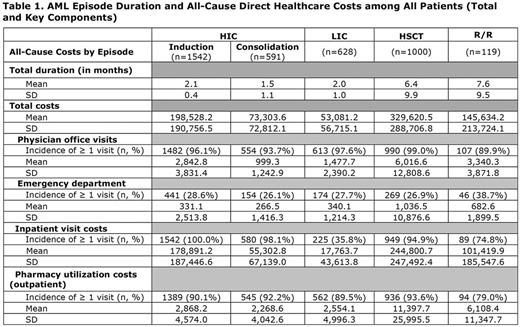Abstract
Background:
AML, a clonal disorder of hematopoietic stem cells, is estimated to affect 21,380 new U.S. patients in 2017. Detailed real-world cost estimates and comparisons of key AML treatment episodes such as high intensity chemotherapy (HIC), low intensity chemotherapy (LIC), hematopoietic stem cell transplant (HSCT) and relapsed-refractory (R/R) patient episodes in the US commercially insured population are scarce and difficult to assemble. This analysis examined the healthcare resource utilization and direct healthcare costs in various AML treatment episodes.
Methods:
Using a large US healthcare claims database (PharMetrics Plus™) and linked charge detail master (CDM) hospital data, incident adult patients with ≥ 2 outpatient or ≥ 1 inpatient claim with an AML diagnosis between 1/1/2008 and 3/31/2016 were identified. To assure adequate data capture, patients were required to have continuous health plan enrollment for ≥ 6 months pre and ≥ 3 months post the first diagnosis date. Episodes evaluated include HIC induction (evidence of inpatient high dose cytarabine+anthracycline use within 3 months of diagnosis), HIC consolidation (evidence of cytarabine +/- anthracycline use within 2 months following prior HIC), LIC (evidence of low-intensity cytarabine, anthracycline, 5-azacytidine, decitabine, clofarabine , hydroxyurea or gemtuzumab ozogamicin in the outpatient setting within 3 months of diagnosis), HSCT (transplant specific diagnosis/procedure codes) and R/R patients (record of an ICD-9 diagnosis code (205.02) for relapsed AML after a prior treatment of HIC, LIC, or HSCT). Patients could contribute to more than one study episode, except HIC induction and LIC, which were mutually exclusive episode groups. Healthcare resource utilization and cost accrual began with treatment episode initiation and ended with initiation of a different AML care episode (active treatment or secondary supportive care) or end of follow-up. All cost and length of episode data are reported as mean (SD), at the population level.
Results:
The final study sample consisted of 1,542 HIC induction (mean age 47.0 years), 591 consolidation (mean age 47.0 years), 628 LIC (mean age 64.9 years), 1,000 HSCT (mean age 51.4 years) and 119 R/R patients (mean age 56.3 years). Total mean (SD) episode cost was highest in HSCT $329,621 ($288,707) with mean follow-up of 6.4 months; followed by HIC induction ($198,528 ($190,757)) with mean follow-up of 2.1 months; R/R cost of $145,634 ($213,724) with mean follow-up of 7.6 months; and HIC consolidation cost of $73,304 ($72,812), mean follow-up 1.5 months (Table 1). The episode cost was the lowest in LIC at $53,081($56,715), 2.0 month follow-up. For HSCT, hospitalization costs were $244,801 ($247,492), while physician office visit costs accrued at $6,017 ($12,809) and outpatient pharmacy costs of $11,398 ($25,996); 26.9% of patients had at least one emergency room (ER) visit that did not lead to hospital admission at a cost of $1,037 ($10,877). All HIC induction required hospitalization and accounted for the most of the HIC cost $178,891 ($294,500), with $2,843 ($3,831) attributed to physician's office visits and $2,868 ($4,574) for outpatient pharmacy; 28.6% had ER visit at a cost of $331 ($2,514). Hospitalization occurred in 74.8% of R/R patients at a cost of $101,420 ($185,548); physician's office visits and outpatient pharmacy costs were $3,340 ($3,872) and $6,108 ($11,348), respectively; 38.7% of patients had at least one ER visit at a cost of $683 ($1,900). For HIC consolidation episodes, hospitalization was the most costly component at $55,301 ($67,139), with $999 ($1,243) for physician's office visits and $2,269 ($4,043) for outpatient pharmacy; 26.1% had ER visit at a cost of $267 ($1,416). Although LIC patients had a relatively low hospitalization rate (35.8%), hospitalization was a major cost component at $17,764 ($43,614); while physician's office visit costs were $1,478 ($2,390) and outpatient pharmacy costs were $2,554 ($4,996), and 27.7% of patients had at least one ER visit at a cost of $340 ($1,214).
Conclusions:
This resource utilization and direct healthcare cost analysis establishes a substantial economic burden associated with various AML treatment episodes, notable during the HIC induction, HSCT and R/R episodes in the US. Hospitalization is a major cost driver across all episodes. New therapeutic strategies associated with less economic burden are needed.
Pandya: Astellas Pharma Global Development: Employment. Chen: QuintilesIMS: Employment. Groves: QuintilesIMS: Employment. Bui: Astellas Pharma Global Development: Employment. Horvath: Astellas Pharma Global Development: Employment. Wade: QuintilesIMS: Employment.
Author notes
Asterisk with author names denotes non-ASH members.


This feature is available to Subscribers Only
Sign In or Create an Account Close Modal